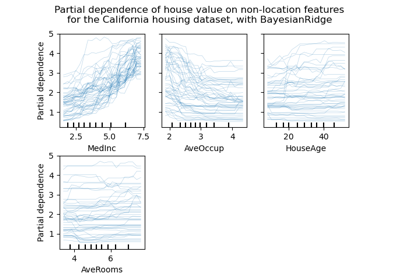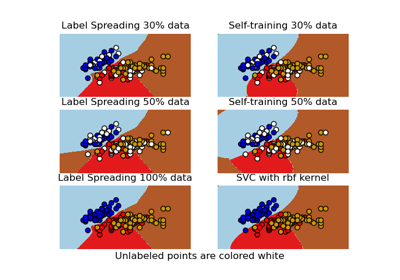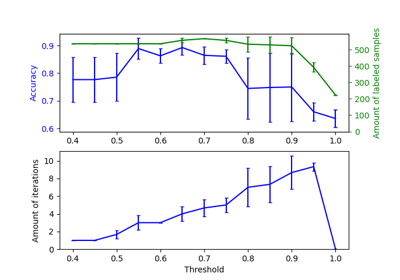sklearn.semi_supervised.SelfTrainingClassifier¶
- class sklearn.semi_supervised.SelfTrainingClassifier(base_estimator, threshold=0.75, criterion='threshold', k_best=10, max_iter=10, verbose=False)[source]¶
Self-training classifier.
This class allows a given supervised classifier to function as a semi-supervised classifier, allowing it to learn from unlabeled data. It does this by iteratively predicting pseudo-labels for the unlabeled data and adding them to the training set.
The classifier will continue iterating until either max_iter is reached, or no pseudo-labels were added to the training set in the previous iteration.
Read more in the User Guide.
- Parameters
- base_estimatorestimator object
An estimator object implementing
fitandpredict_proba. Invoking thefitmethod will fit a clone of the passed estimator, which will be stored in thebase_estimator_attribute.- thresholdfloat, default=0.75
The decision threshold for use with
criterion='threshold'. Should be in [0, 1). When using the'threshold'criterion, a well calibrated classifier should be used.- criterion{‘threshold’, ‘k_best’}, default=’threshold’
The selection criterion used to select which labels to add to the training set. If
'threshold', pseudo-labels with prediction probabilities abovethresholdare added to the dataset. If'k_best', thek_bestpseudo-labels with highest prediction probabilities are added to the dataset. When using the ‘threshold’ criterion, a well calibrated classifier should be used.- k_bestint, default=10
The amount of samples to add in each iteration. Only used when
criterion='k_best'.- max_iterint or None, default=10
Maximum number of iterations allowed. Should be greater than or equal to 0. If it is
None, the classifier will continue to predict labels until no new pseudo-labels are added, or all unlabeled samples have been labeled.- verbosebool, default=False
Enable verbose output.
- Attributes
- base_estimator_estimator object
The fitted estimator.
- classes_ndarray or list of ndarray of shape (n_classes,)
Class labels for each output. (Taken from the trained
base_estimator_).- transduction_ndarray of shape (n_samples,)
The labels used for the final fit of the classifier, including pseudo-labels added during fit.
- labeled_iter_ndarray of shape (n_samples,)
The iteration in which each sample was labeled. When a sample has iteration 0, the sample was already labeled in the original dataset. When a sample has iteration -1, the sample was not labeled in any iteration.
- n_features_in_int
Number of features seen during fit.
New in version 0.24.
- feature_names_in_ndarray of shape (
n_features_in_,) Names of features seen during fit. Defined only when
Xhas feature names that are all strings.New in version 1.0.
- n_iter_int
The number of rounds of self-training, that is the number of times the base estimator is fitted on relabeled variants of the training set.
- termination_condition_{‘max_iter’, ‘no_change’, ‘all_labeled’}
The reason that fitting was stopped.
'max_iter':n_iter_reachedmax_iter.'no_change': no new labels were predicted.'all_labeled': all unlabeled samples were labeled beforemax_iterwas reached.
See also
LabelPropagationLabel propagation classifier.
LabelSpreadingLabel spreading model for semi-supervised learning.
References
David Yarowsky. 1995. Unsupervised word sense disambiguation rivaling supervised methods. In Proceedings of the 33rd annual meeting on Association for Computational Linguistics (ACL ‘95). Association for Computational Linguistics, Stroudsburg, PA, USA, 189-196. DOI: https://doi.org/10.3115/981658.981684
Examples
>>> import numpy as np >>> from sklearn import datasets >>> from sklearn.semi_supervised import SelfTrainingClassifier >>> from sklearn.svm import SVC >>> rng = np.random.RandomState(42) >>> iris = datasets.load_iris() >>> random_unlabeled_points = rng.rand(iris.target.shape[0]) < 0.3 >>> iris.target[random_unlabeled_points] = -1 >>> svc = SVC(probability=True, gamma="auto") >>> self_training_model = SelfTrainingClassifier(svc) >>> self_training_model.fit(iris.data, iris.target) SelfTrainingClassifier(...)
Methods
Call decision function of the
base_estimator.fit(X, y)Fit self-training classifier using
X,yas training data.get_params([deep])Get parameters for this estimator.
predict(X)Predict the classes of
X.Predict log probability for each possible outcome.
Predict probability for each possible outcome.
score(X, y)Call score on the
base_estimator.set_params(**params)Set the parameters of this estimator.
- decision_function(X)[source]¶
Call decision function of the
base_estimator.- Parameters
- X{array-like, sparse matrix} of shape (n_samples, n_features)
Array representing the data.
- Returns
- yndarray of shape (n_samples, n_features)
Result of the decision function of the
base_estimator.
- fit(X, y)[source]¶
Fit self-training classifier using
X,yas training data.- Parameters
- X{array-like, sparse matrix} of shape (n_samples, n_features)
Array representing the data.
- y{array-like, sparse matrix} of shape (n_samples,)
Array representing the labels. Unlabeled samples should have the label -1.
- Returns
- selfobject
Fitted estimator.
- get_params(deep=True)[source]¶
Get parameters for this estimator.
- Parameters
- deepbool, default=True
If True, will return the parameters for this estimator and contained subobjects that are estimators.
- Returns
- paramsdict
Parameter names mapped to their values.
- predict(X)[source]¶
Predict the classes of
X.- Parameters
- X{array-like, sparse matrix} of shape (n_samples, n_features)
Array representing the data.
- Returns
- yndarray of shape (n_samples,)
Array with predicted labels.
- predict_log_proba(X)[source]¶
Predict log probability for each possible outcome.
- Parameters
- X{array-like, sparse matrix} of shape (n_samples, n_features)
Array representing the data.
- Returns
- yndarray of shape (n_samples, n_features)
Array with log prediction probabilities.
- predict_proba(X)[source]¶
Predict probability for each possible outcome.
- Parameters
- X{array-like, sparse matrix} of shape (n_samples, n_features)
Array representing the data.
- Returns
- yndarray of shape (n_samples, n_features)
Array with prediction probabilities.
- score(X, y)[source]¶
Call score on the
base_estimator.- Parameters
- X{array-like, sparse matrix} of shape (n_samples, n_features)
Array representing the data.
- yarray-like of shape (n_samples,)
Array representing the labels.
- Returns
- scorefloat
Result of calling score on the
base_estimator.
- set_params(**params)[source]¶
Set the parameters of this estimator.
The method works on simple estimators as well as on nested objects (such as
Pipeline). The latter have parameters of the form<component>__<parameter>so that it’s possible to update each component of a nested object.- Parameters
- **paramsdict
Estimator parameters.
- Returns
- selfestimator instance
Estimator instance.




